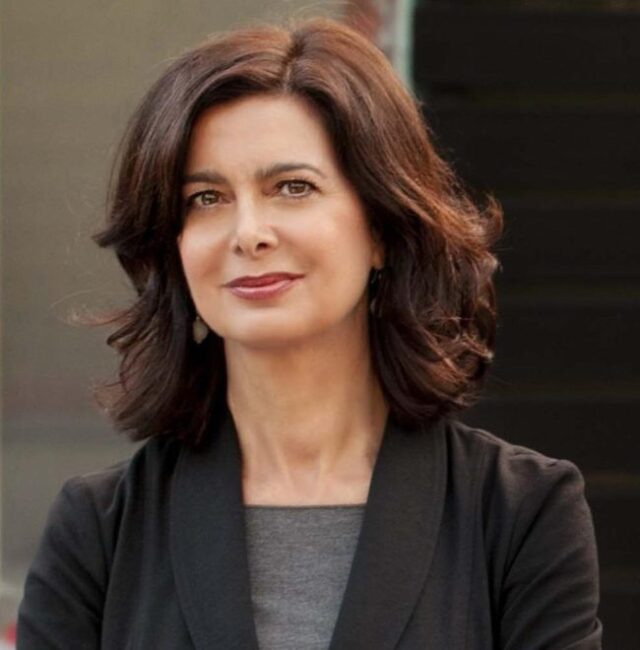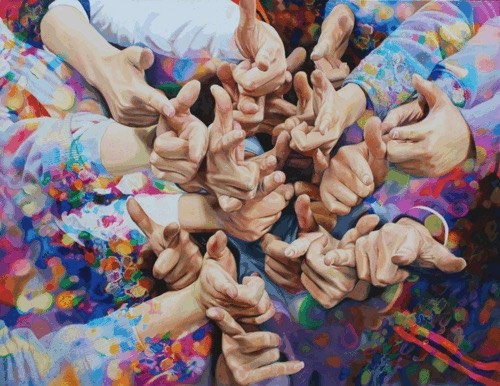
L’arte coreana è stata legata per molti millenni a quella cinese e a quella giapponese, soprattutto nei periodi più antichi quando cioè a dominare la società erano le grandi dinastie che governavano quei regni contigui e vicini anche dal punto di vista culturale; allo stesso modo che in occidente, nel passato più remoto le rappresentazioni artistiche erano fortemente legate alla religione, il Buddhismo prima e il Confucianesimo poi, senza mai trascurare, negli ambienti più intellettuali, la bellezza dell’Arte Calligrafica che in oriente è sempre stata considerata come una delle massime espressioni artistiche. Fu intorno al Quindicesimo secolo che gli artisti, in particolare con Un Geyon e con Hwang Jipjung, cominciarono ad avvicinarsi a un maggiore Realismo, spogliato dalle iconografie religiose e più concentrato sui paesaggi o sulla vita comune, lasciando così una forte testimonianza della bellezza degli abiti tradizionali e della solennità della vita di quei secoli. Dunque l’Arte Calligrafica e quella Popolare costituirono due estremi espressivi in Corea, spesso contrapposti poiché dagli intellettuali che realizzavano la pittura segnica prevalentemente bi-cromatica l’uso del colore era considerato grossolano, quasi volgare, mentre per i realisti la rappresentazione visiva era funzionale a permettere alle persone di apprezzare e comprendere l’arte proprio perché parlava degli usi e dei variopinti costumi del loro vissuto quotidiano. La liberazione della Corea da parte dell’occidente dopo la resa del Giappone del 1945 permise di introdurre nelle Accademie lo studio dei grandi maestri europei e così le nuove generazioni di pittori si spostarono verso stili più in linea con la direzione che stava prendendo l’arte mondiale, assorbendo le esperienze degli Espressionisti, dei Cubisti, e anche degli Astrattisti. Il Ventesimo secolo fu perciò anche in Corea un periodo di libertà dalle tradizioni pittoriche e di reinterpretazione soggettiva delle tematiche più moderne, come nell’Espressionismo Surrealista di Chang Ucchin, che mostra la medesima spontaneità e semplicità rappresentativa del catalano Joan Mirò, o come nell’Astrattismo Lirico di Seund Ja Rhee dove la delicatezza della gamma cromatica e la leggerezza delle figure informali non può non ricondurre alle antiche carte di riso e della tecnica degli origami. Nel Ventunesimo secolo le forti influenze occidentali della Corea del Sud hanno condotto i creativi a voler emergere nel panorama internazionale abbandonando le tradizioni del passato che tanto li avevano contraddistinti, per avvicinarsi a un linguaggio stilistico più universale e comprensibile; è proprio in questo contesto che si inserisce la figura artistica di Su Hyun Kim, giovane interprete che sceglie volutamente di lavorare per serie pittoriche e che in quella che andremo ad approfondire oggi mostra il suo essere in bilico tra l’assoluta modernità di uno stile riconducibile al Realismo, e il desiderio di non cancellare quella realtà classica in cui molti coreani ancora vivono, esaltando quanto nella quotidianità restino vive abitudini, usi e costumi che si scontrano a volte con la corsa verso il progresso e la tecnologia ormai parte del vivere comune.
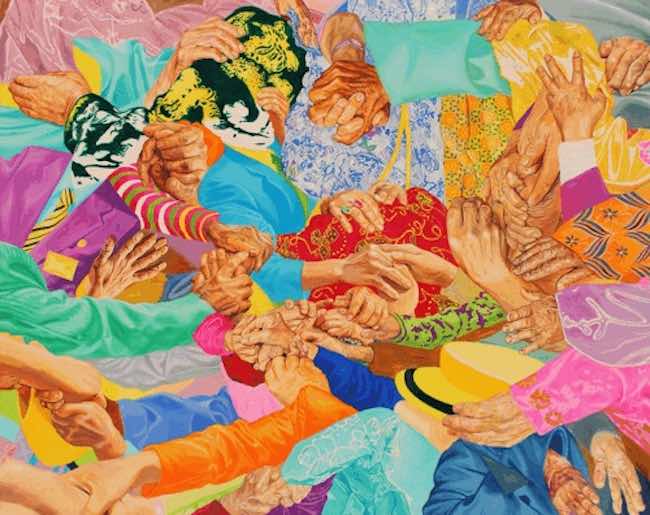
Non solo, l’anima pittorica di Su Hyun Kim svela anche la realtà di un popolo per il quale la divisione dovuta a ragioni politiche e coloniali rappresenta una ferita, una distanza mai sanata con i propri simili, e forse persino con parenti troppo distanti per appartenere allo stesso lato della divisione, che non riesce a essere dimenticata proprio perché radicata nel destino comune degli abitanti di quei luoghi.
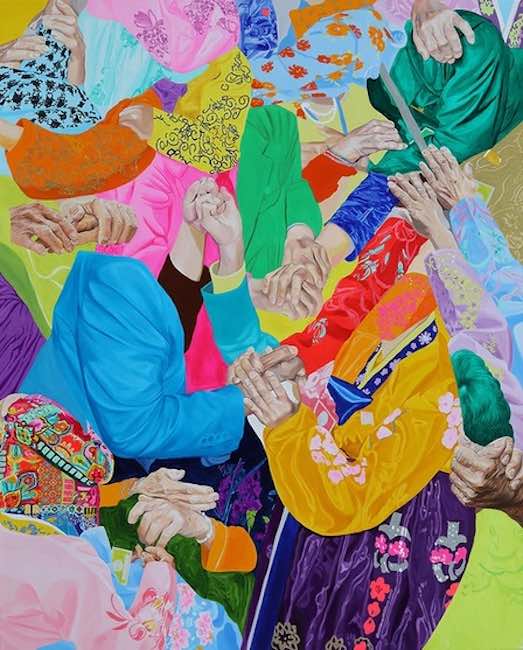
Dunque nella serie Tide (Marea) le mani, assolute protagoniste della maggior parte dei dipinti, mostrano tutta la loro espressività, la soggettività di persone divise eppure unite in maniera indissolubile in virtù delle tradizioni comuni, che cercano quel contatto perduto, quel senso di appartenenza rivivibile solo nel momento dell’incontro, a dispetto di tutta quella tecnologia che illude le persone di essere vicine ma inducendole a dimenticare l’importanza della presenza, vera, reale, con chi è emotivamente importante.
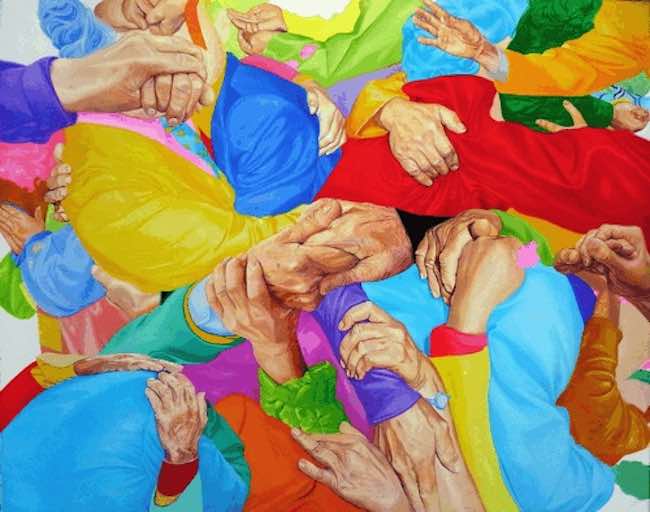
Il groviglio di mani esprime la personalità, il sentire, l’atteggiamento di ciascun singolo personaggio di cui non si vede il volto, così come importante è l’intravedersi degli abiti tradizionali solo apparentemente superati dalla modernità ma di fatto elemento essenziale delle radici di un popolo che vuole tendere verso la velocità del progresso senza mai dimenticare il punto di partenza. La marea a cui è intitolata la serie è dunque quella umana, quella trasportata dagli eventi e dalle circostanze ma sempre in grado di oltrepassare le difficoltà quando rimane legata agli affetti, al sottogruppo più importante, quello cioè dei sentimenti solidi, dei legami familiari e del piacere di trovarsi per stringersi gli uni agli altri.
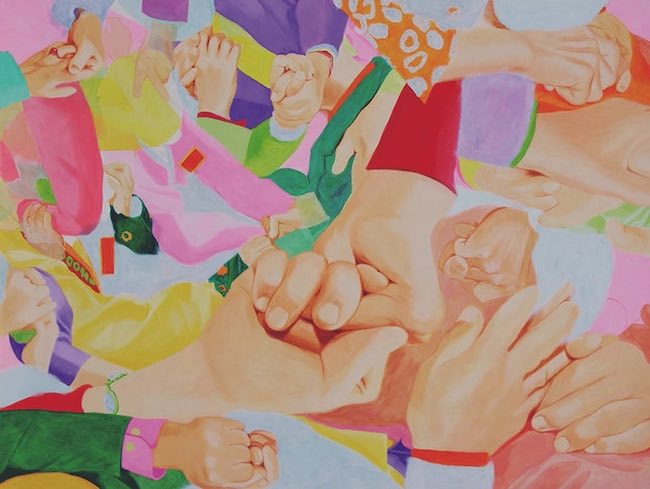
In Happy home Encounter V l’occasione raccontata sembra essere quella di un compleanno, di celebrazione di un momento importante in cui è riunita l’intera famiglia, ecco perché le mani che si stringono sono quelle di bambini e di adulti, fratelli, genitori, tutti insieme per il semplice piacere di farlo, approfittando di un’occasione particolare anche per mettere in secondo piano le rivalità, le discussioni e ciò che normalmente accade all’interno dei legami di parentela. L’approccio pittorico di Su Hyun Kim è fortemente realista eppure in qualche modo in virtù dell’utilizzo della gamma cromatica chiara e delicata sembra quasi tendere verso un’irrealtà di tipo surrealista, come se quel groviglio di gestualità singole e personali nascondesse significati profondi e indecifrabili che hanno bisogno di essere osservati andando oltre la patina superficiale e studiati nella loro unicità.
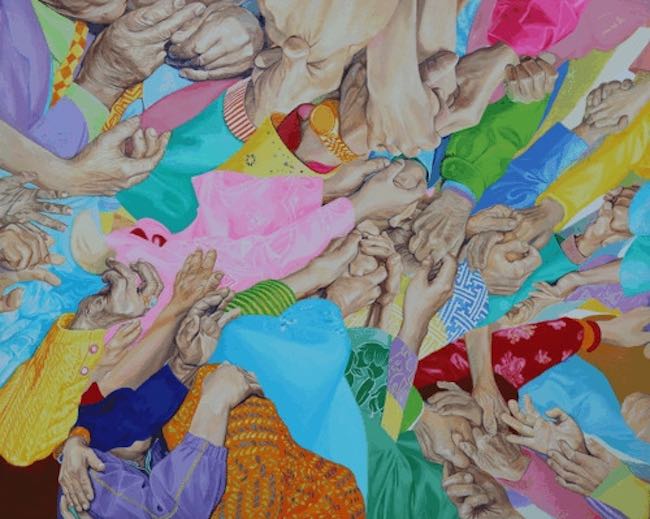
Nel dipinto The Genesis invece l’artista esplora il senso della vita, quell’essere giovani pur sapendo di dover giungere inevitabilmente alla terza età, quella della saggezza, quella che può insegnare molto pur sapendo che solo attraverso l’esperienza personale essa verrà conquistata dal singolo individuo; le mani piene di rughe stringono perciò quelle più giovani cercando di trasmettere loro la propria conoscenza senza però imporre nulla, con la delicatezza di chi sa di dover lasciare spazio a un corso della vita che non può essere modificato attraverso consigli e suggerimenti. In qualche modo dalla tela emerge anche la fragilità che gli anziani raggiungono necessitando così, nel loro essere portatori e narratori di tradizioni, di essere protetti tanto quanto i bambini, i primi come depositari di memorie inconoscibili se non attraverso i loro racconti, i secondi come gemme che poi costruiranno il nuovo futuro.
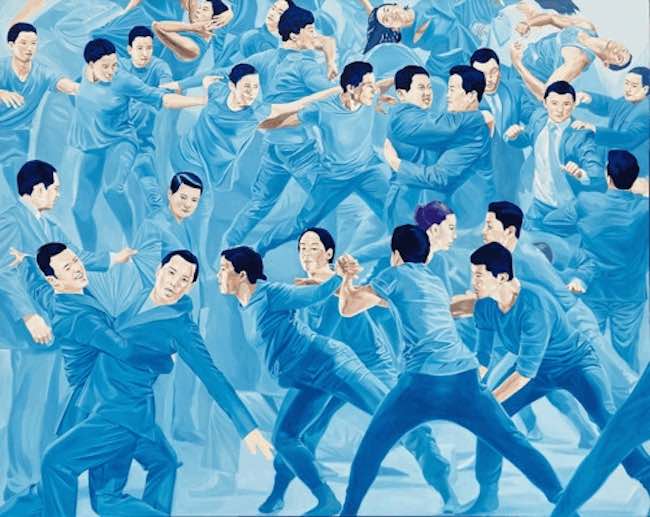
Le tele Blue land e Pink Paradise, contrariamente a tutto il resto della serie pittorica, mostrano anche i volti dei personaggi, come se i loro corpi fossero impegnati in una danza teatrale funzionale a convincere gli ignari spettatori della trasparenza e della positività delle loro intenzioni; emerge il tema dell’apparenza della politica in questi dipinti, dove i protagonisti inscenano quotidianamente le commedie per ottenere il favore del pubblico ma di fatto pensando solo e unicamente al loro tornaconto personale, in oriente come in occidente d’altronde.
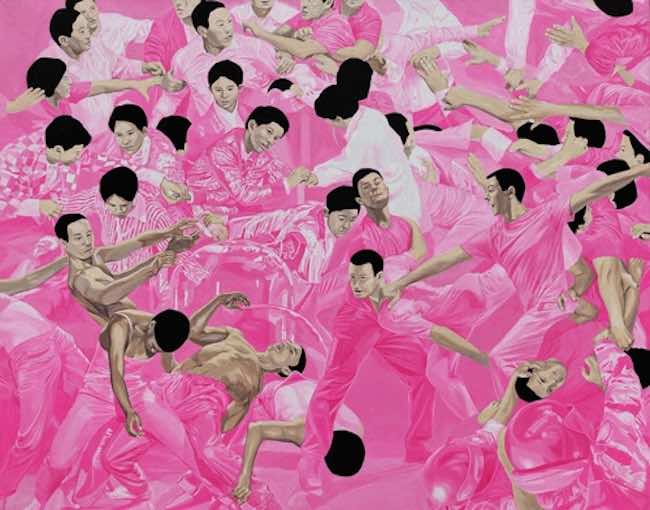
I corpi sono volutamente immortalati in pose plastiche e poco naturali, a volte guardando verso l’osservatore, altre irridendo l’avversario, in alcuni casi ammiccando verso lo spettatore immaginario, rendendo leggero un tema che invece è un cardine della realtà contemporanea e cioè quello dell’assoggettamento della classe dirigente ai poteri forti e l’inesistenza di volontà, tranne in rari casi, di fare solo e unicamente gli interessi del popolo. Su Hyun Kim ha al suo attivo quattro mostre personali in Corea, la partecipazione a molte mostre collettive e fiere d’arte in Corea, in Francia e negli Stati Uniti ed è stata finalista a diversi premi d’arte in tutto il mondo.
SU HYUN KIM-CONTATTI
Email: kimsu814@gmail.com
Sito web: www.suhyun-kim.com/
Instagram: www.instagram.com/kimsu814/
Twitter: www.twitter.com/Suhyun__Kim
The incisive expressiveness of the hands in Su Hyun Kim’s Korean Realism, when human contact conceals conflicting emotions
The contemporary individual’s awareness is to be constantly part of a group of people, from the narrowest of family circles to the largest of social classes or race or religious beliefs, which on the one hand can certainly be reassuring because staying within a comfort zone removes the risks of unknowns, but on the other hand somehow limits the individuality and autonomy of those who feel a greater need to assert their personality regardless of the sense of belonging in which others feel comfortable. The artistic attitude that derives from this realisation may tend towards the need to break out of any scheme by going to explore the infinite possibilities that emerge outside of those social groupings and observing the different manifestations of freedom, or investigate the adherence to conventions and behaviours that are linked to the choice to conform, becoming witnesses to the facets that manifest themselves in each individual. Today’s protagonist belongs to the latter category.
Korean art has been linked for many millennia to Chinese and Japanese art, especially in the earliest periods when society was dominated by the great dynasties that ruled those neighbouring and culturally close kingdoms; in the same way as in the West, in the more distant past, artistic representations were strongly linked to religion, first Buddhism and then Confucianism, without ever neglecting, in the more intellectual circles, the beauty of Calligraphic Art, which in the East has always been considered one of the highest artistic expressions. It was around the 15th century that artists, particularly with Un Geyon and Hwang Jipjung, began to move towards a greater Realism, stripped of religious iconography and more focused on landscapes or common life, thus leaving a strong testimony of the beauty of traditional dress and the solemnity of life in those centuries. Thus, Calligraphic Art and Folk Art constituted two expressive extremes in Korea, which were often contrasted, as for the intellectuals who produced predominantly two-colour sign painting, the use of colour was considered coarse, almost vulgar, while for the realists, the visual representation was functional to allow people to appreciate and understand the art precisely because it spoke of the customs and colourful habits of their daily life. The liberation of Korea by the West after the surrender of Japan in 1945 made it possible to introduce the study of the great European masters into the Academies, and so the new generations of painters moved towards styles more in line with the direction that world art was taking, absorbing the experiences of the Expressionists, the Cubists, and even the Abstractionists.
The 20th century was thus also in Korea a period of freedom from pictorial traditions and subjective reinterpretation of more modern themes, as in the Surrealist Expressionism of Chang Ucchin, who shows the same spontaneity and representational simplicity as the Catalan Joan Mirò, or as in the Lyrical Abstractionism of Seund Ja Rhee where the delicacy of the colour range and the lightness of the informal figures cannot fail to lead back to ancient rice paper and origami technique. In the 21st century, South Korea’s strong Western influences have led creative artists to want to emerge on the international scene, abandoning the traditions of the past that had distinguished them so much, in order to approach a more universal and comprehensible stylistic language; it is precisely in this context that the artistic figure of Su Hyun Kim fits in, a young artist who deliberately chooses to work with pictorial series and who, in the one we are going to explore today, shows his being poised between the absolute modernity of a style that can be traced back to Realism, and the desire not to erase the classical reality in which many Koreans still live, exalting the extent to which habits, customs and traditions remain alive in daily life, sometimes clashing with the race towards progress and technology that is now part of common life. Not only that, Su Hyun Kim‘s pictorial soul also unveils the reality of a people for whom the division due to political and colonial reasons represents a wound, a distance never healed with their own kind, and perhaps even with relatives too distant to belong to the same side of the division, which cannot be forgotten precisely because it is rooted in the common destiny of the inhabitants of those places. So in the Tide series, the hands, the absolute protagonists of most of the paintings, show all their expressiveness, the subjectivity of people divided yet indissolubly united by virtue of common traditions, who seek that lost contact, that sense of belonging that can only be relived in the moment of meeting, in spite of all that technology that deludes people into thinking they are close but induces them to forget the importance of real, true presence with those who are emotionally important.
The tangle of hands expresses the personality, the feeling, the attitude of each individual character whose face cannot be seen, just as important is the glimpse of traditional clothes only apparently overtaken by modernity but in fact an essential element of the roots of a people who want to tend towards the speed of progress without ever forgetting their starting point. The tide to which the series is entitled is therefore the human one, the one transported by events and circumstances but always capable of overcoming difficulties when it remains bound to affection, to the most important subgroup, that of solid feelings, family ties and the pleasure of finding oneself to hold one another close. In Happy home encounter V, the occasion recounted seems to be that of a birthday, the celebration of an important moment in which the entire family is reunited, that is why the hands that are shaken are those of children and adults, siblings, parents, all together for the simple pleasure of doing so, taking advantage of a special occasion also to put rivalries, arguments and what normally happens within the bonds of kinship into the background. Su Hyun Kim‘s pictorial approach is strongly realist, yet somehow by virtue of the use of the light and delicate chromatic range, it almost seems to tend towards a surrealist type of unreality, as if that tangle of individual and personal gestures were hiding profound and indecipherable meanings that need to be observed by going beyond the superficial patina and studied in their uniqueness. In the painting The Genesis, on the other hand, the artist explores the meaning of life, that of being young despite knowing that one must inevitably reach the third age, that of wisdom, that which can teach a great deal even though one knows that only through personal experience will it be conquered by the individual; the wrinkled hands therefore clasp the younger ones, trying to transmit their knowledge to them without imposing anything, with the delicacy of those who know they must leave room for a course of life that cannot be altered through advice and suggestions. Somehow the canvas also reveals the fragility that the elderly reach, needing, in their being bearers and narrators of traditions, to be protected as much as the children, the former as repositories of memories unknowable except through their stories, the latter as gems that will then build the new future. The canvases Blue land and Pink Paradise, in contrast to the rest of the pictorial series, also show the faces of the characters, as if their bodies were engaged in a theatrical dance designed to convince the unsuspecting spectators of the transparency and positivity of their intentions; the theme of the appearance of politics emerges in these paintings, where the protagonists stage plays every day to gain the public’s favour but in fact thinking only and solely of their personal gain, in the East as in the West however. The bodies are deliberately immortalised in plastic and unnatural poses, sometimes looking towards the observer, sometimes mocking the opponent, in some cases winking towards the imaginary spectator, making light of a theme that is instead a cornerstone of contemporary reality, namely that of the subjugation of the ruling class to the strong powers and the non-existence of the will, except in rare cases, to do only and exclusively the interests of the people. Su Hyun Kim has to her credit four solo exhibitions in Korea, participation in many group exhibitions and art fairs in Korea, France and the USA, and has been a finalist in several art awards worldwide.









